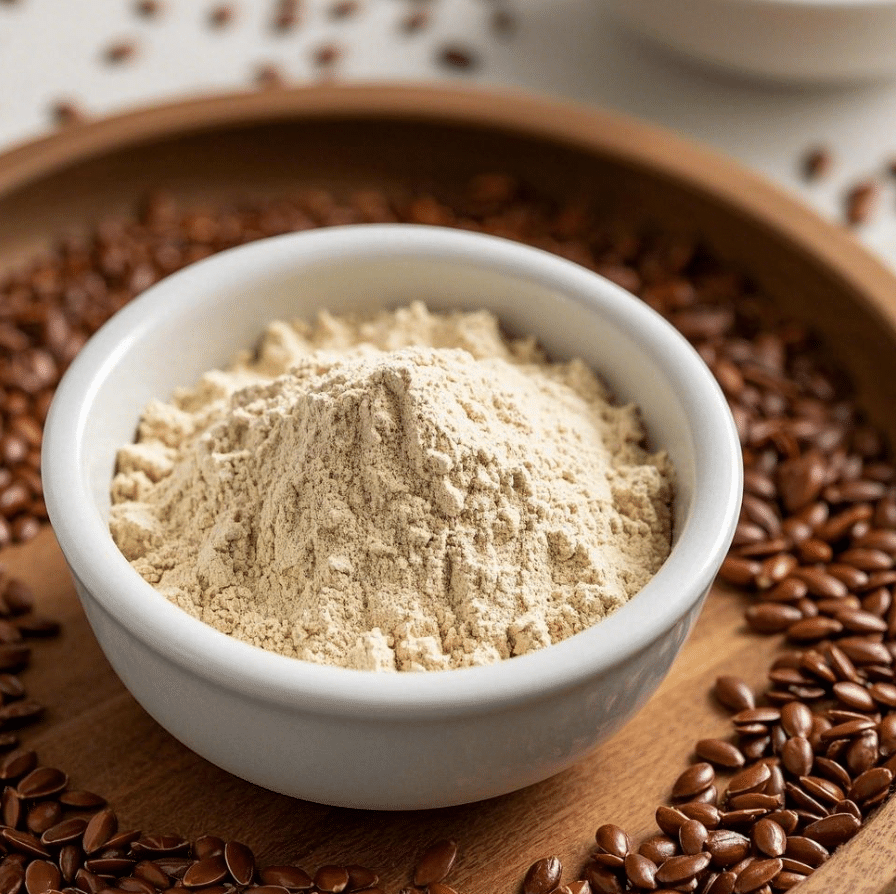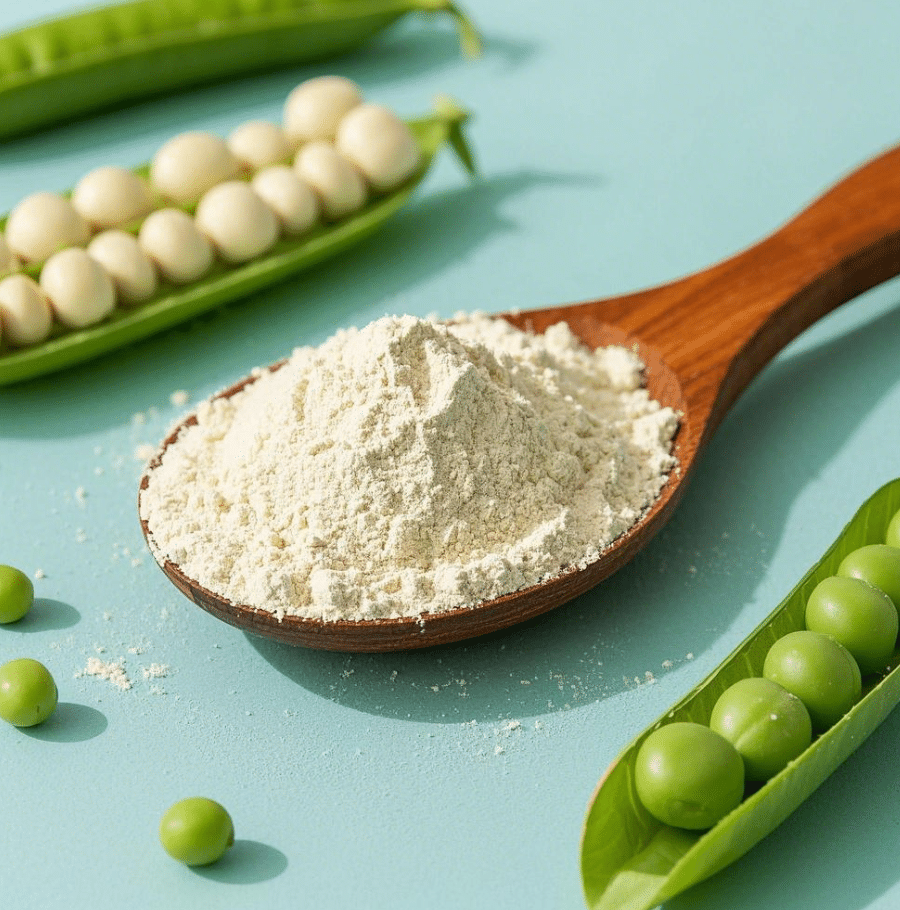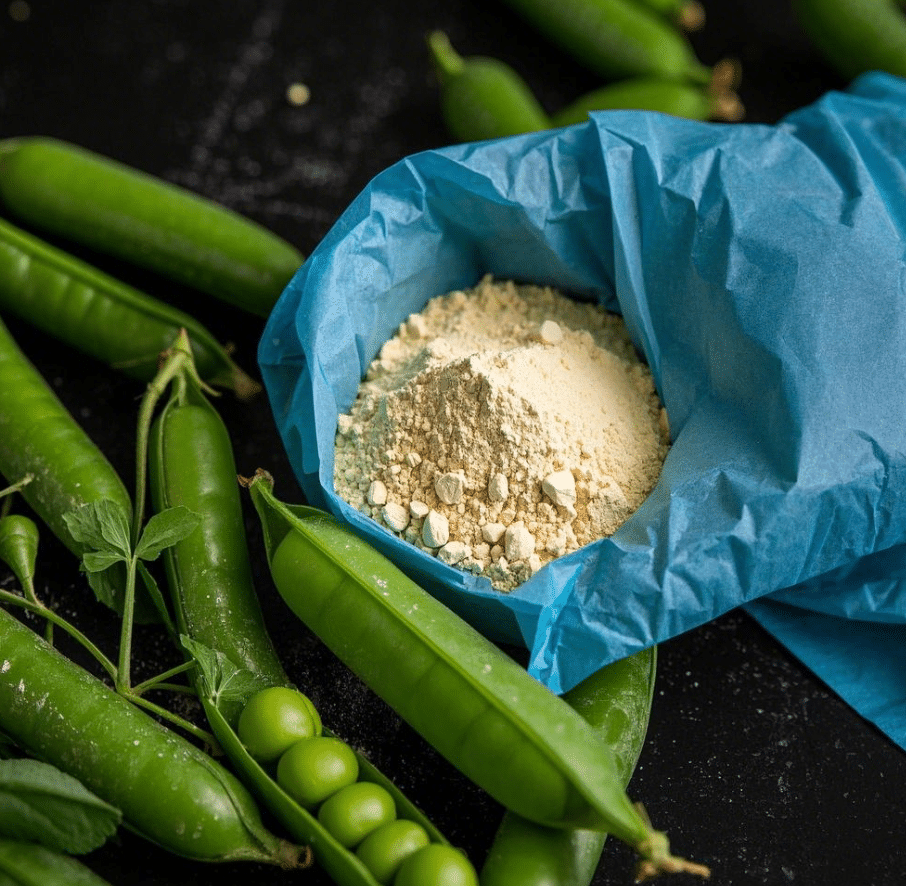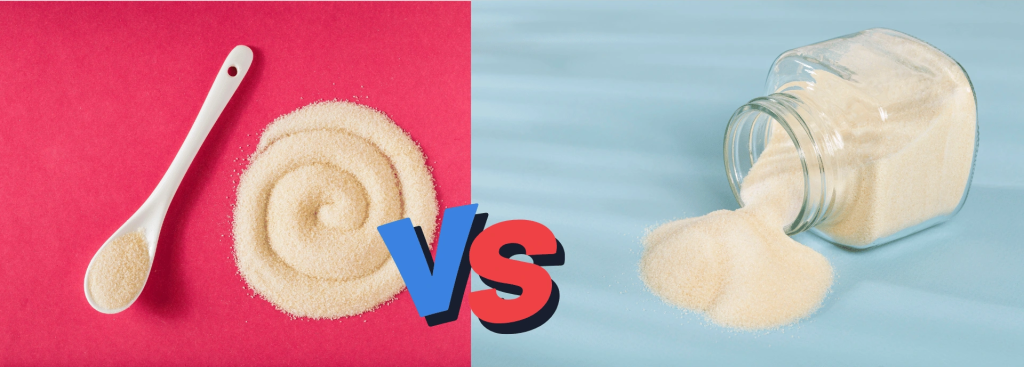Flaxseed Protein Powder Vs Pea Protein Powder: The Ultimate B2B Comparison Guide
Let’s get real for a second—navigating the plant protein space in 2023 feels like trying to find your way through a maze blindfolded. Everyone’s talking about sustainability, protein quality, and meeting consumer demands, but which ingredients actually deliver? As someone who’s spent over a decade working with manufacturers across the plant protein supply chain, I’ve seen firsthand how the right choice between flaxseed protein powder vs pea protein powder can make or break a product line.
These two plant-based powerhouses have been absolutely crushing it in the market lately, but they’re wildly different in practically every way that matters to your bottom line. Whether you’re formulating the next big protein bar, planning to diversify your plant protein portfolio, or simply trying to figure out if switching suppliers makes sense, this comprehensive breakdown will save you months of trial and error (and probably a few headaches too).
No cap—I’m spilling all the industry tea today, from processing methods that suppliers rarely discuss openly to the regulatory hurdles that could tank your international expansion plans. Let’s dive in!
Essential Identification Information
Before we get into the nitty-gritty comparison, let’s lay out the basic identifying information for both protein sources:
- Common Names: Flax protein, linseed protein powder
- Latin Name: Protein from Linum usitatissimum
- CAS Number: Not specifically assigned (flaxseed oil is 8001-26-1)
- Production Standards: FSSC 22000, ISO 9001, HACCP
- Appearance: Fine light tan to golden powder
- Flavor Profile: Mild nutty taste with earthy notes
- Processing Solvents: Primarily water-based extraction; some use hexane-free processes
- Typical Specifications: 35-60% protein content
- Common Mesh Size: 80-120 mesh
- Import Tariffs: ~6.4% in US; 3-5% in EU
- HS Code: Usually classified under 2106.10
- Shelf Life: 18-24 months when properly stored
- Storage Requirements: Cool, dry place in sealed containers
- Standard Packaging: 25kg kraft paper bags with PE liner
- Common Names: Pea protein isolate, pea protein concentrate
- Latin Name: Protein from Pisum sativum
- CAS Number: 100860-44-0
- Production Standards: FSSC 22000, ISO 9001, HACCP
- Appearance: Fine light beige to yellow powder
- Flavor Profile: Distinctly beany/earthy taste
- Processing Solvents: Water and salt solutions; acid/alkaline precipitation
- Typical Specifications: 75-85% protein content (isolate), 55-75% (concentrate)
- Common Mesh Size: 80-200 mesh
- Import Tariffs: ~6.5% in US; 3-5% in EU
- HS Code: Usually classified under 2106.10
- Shelf Life: 24 months when properly stored
- Storage Requirements: Cool, dry place in sealed containers
- Standard Packaging: 20-25kg kraft paper bags with PE liner
The Origin Stories: How Did We Get Here?
Flaxseed Protein Powder: While flaxseed has been cultivated for thousands of years, flaxseed protein powder as a commercial ingredient emerged much more recently. The intentional development of flaxseed protein as a stand-alone ingredient began around the early 2000s, primarily driven by Canadian agricultural research institutes (not surprising since Canada produces ~40% of the world’s flaxseed).
Commercial production scaling began around 2010, largely as a byproduct opportunity from flaxseed oil processing. Initial market entry focused on utilizing what had previously been considered a secondary product from oil extraction.
Pea Protein Powder: Pea protein has a slightly longer commercial history, with meaningful production beginning in the 1990s. French researchers were early pioneers in developing commercially viable extraction methods, with companies in France and Canada leading early manufacturing scale-up.
The major breakthrough for pea protein came around 2013-2015 when advances in flavor technology and processing methods dramatically improved its sensory properties and functionality. This technological leap transformed pea protein from a niche ingredient into the plant protein heavyweight it is today.
Physical Characteristics: Form & Function
Flaxseed Protein Powder Forms:
- Standard powder (35-40% protein)
- Protein concentrate (45-55% protein)
- Protein isolate (55-60% protein)
- Textured protein (for meat alternatives)
The majority of flaxseed protein in the market exists as standard powder, with smaller volumes of concentrates and isolates available for premium applications. It’s worth noting that achieving higher protein concentrations with flaxseed is technically challenging due to its complex seed matrix.
Pea Protein Powder Forms:
- Concentrate (55-75% protein)
- Isolate (75-85% protein)
- Textured protein (for meat alternatives)
- Hydrolyzed pea protein (enhanced solubility)
Pea protein isolate dominates the market, representing approximately 70% of total pea protein volume, with concentrates making up most of the remainder. The higher protein concentration achievable with pea protein makes it particularly attractive for applications where protein density matters.
Production Aids & Processing Ingredients
Flaxseed Protein Production Typically Involves:
- Whole flaxseeds or flaxseed meal (often partially defatted)
- Processing enzymes (in some extraction methods)
- pH adjusters (for protein precipitation)
- Food-grade filtration media
- Anti-caking agents (in some formulations)
Pea Protein Production Typically Involves:
- Dry yellow peas (split peas)
- Salt solutions (for protein solubilization)
- pH adjusters (acids and bases for protein precipitation)
- Processing enzymes (for starch removal)
- Food-grade filtration media
- Anti-caking agents (in some formulations)
Both ingredients typically undergo processing to remove anti-nutritional factors – enzyme inhibitors in pea protein and cyanogenic compounds in flaxseed protein. The efficiency of these processes significantly impacts final product quality and digestibility.
Solubility Characteristics: The Formulator’s Challenge
One of the most critical functional properties for any protein ingredient is its solubility profile, which directly impacts application versatility.
Flaxseed Protein Solubility:
- Moderate water solubility
- Better dispersion than true solution formation
- Enhanced solubility at mildly alkaline pH
- Improved performance when mechanical agitation is applied
- Typically requires stabilizers in beverage applications
Pea Protein Solubility:
- Moderate to good water solubility (isolate)
- U-shaped solubility curve (more soluble at very low and high pH)
- Better cold-water solubility than many plant proteins
- Newer specialized grades offer enhanced solubility
- Performance varies significantly between suppliers
In direct comparison, standard pea protein isolate typically demonstrates better overall solubility than standard flaxseed protein, though specialized grades of each can be engineered for specific solubility profiles. Many formulators find that pea protein’s solubility advantage makes it easier to work with in beverage applications, while the difference is less significant in solid food applications.
Market Applications: Where They Shine
Flaxseed Protein Powder Applications:
- Plant-based protein blends (as complementary protein)
- Allergen-free formulations
- Clean label baked goods
- Organic product lines
- Functional foods targeting omega-3 content
- Specialty products like flaxseed chutney powder
Pea Protein Powder Applications:
- Dairy alternatives (milk, yogurt, cheese)
- Meat alternatives
- High-protein beverages
- Sports nutrition products
- Plant-based protein bars
- Bakery protein fortification
The application mapping reveals an interesting pattern: pea protein dominates in applications where protein content is the primary selling feature, while flaxseed protein finds its niche in formulations where its additional nutritional attributes (omega-3s, lignans) are valued alongside its protein contribution.
Manufacturing Methods: How They’re Made
Flaxseed Protein Production Process:
The production of flaxseed protein powder typically follows one of two main pathways:
-
Dry Process:
- Cleaning and preparation of flaxseeds
- Mechanical pressing to remove oil
- Milling of press cake
- Air classification to separate protein fraction
- Fine milling to target particle size
- Blending and standardization
- Packaging
-
Wet Process:
- Cleaning and preparation of flaxseeds
- Optional de-fatting
- Alkaline extraction
- Separation of solids
- Protein precipitation by pH adjustment
- Centrifugation and collection
- Neutralization
- Drying
- Milling to target particle size
- Packaging
The wet process typically yields a higher protein content but at greater processing cost and environmental impact.
Pea Protein Production Process:
Pea protein is almost exclusively produced through wet processing:
- Standard Wet Process:
- Cleaning and preparation of dry peas
- Milling to flour consistency
- Starch separation (often enzymatic)
- Protein solubilization (alkaline extraction)
- Clarification/filtration
- Protein precipitation (acidification)
- Separation/centrifugation
- Neutralization
- Spray drying
- Milling to target particle size
- Packaging
Recent innovations include membrane filtration technologies that improve both yield and functional properties while reducing water and energy consumption.
Nutritional Benefits & Functionality: Protein Quality Face-Off
When it comes to the fundamental purpose of a protein ingredient – delivering nutrition – how do these two plant proteins compare?
Flaxseed Protein Benefits:
- Complete amino acid profile with all essential amino acids
- Rich in arginine and glutamine
- Contains small amounts of residual omega-3 fatty acids
- Typically contains 3-5% fiber
- Retains beneficial lignans with antioxidant properties
- PDCAAS score of approximately 0.62-0.75
- Lower allergenicity risk
- Natural non-GMO status
Pea Protein Benefits:
- Complete amino acid profile with all essential amino acids
- Particularly rich in lysine (often limiting in plant proteins)
- Higher leucine content (valuable for muscle protein synthesis)
- Higher overall protein content (75-85% for isolates)
- PDCAAS score of approximately 0.70-0.85
- Robust supply chain and price stability
- Natural non-GMO status
- Lower environmental footprint
The protein quality comparison reveals complementary strengths. Pea protein excels in total protein content and leucine levels (important for muscle recovery), while flaxseed protein offers additional nutritional components alongside its protein content.
Side Effect Profiles: The Safety Question
Both ingredients are generally recognized as safe, but there are some considerations to be aware of:
Flaxseed Protein Potential Side Effects:
- Initial digestive adjustment period for some consumers
- Natural enzyme inhibitors that may affect protein digestion
- Potential allergenic response in sensitive individuals (rare)
- Natural compounds that may affect hormone metabolism in very high doses
- Possible interaction with blood-thinning medications due to residual omega-3s
Pea Protein Potential Side Effects:
- Digestive discomfort in some individuals (bloating, gas)
- Potential cross-reactivity in people with severe legume allergies
- Purines content (consideration for those with gout)
- Natural anti-nutritional factors if inadequately processed
- Residual lectins if inadequately processed
Both ingredients have excellent safety profiles overall, with documented side effects being mild and uncommon when consumed in normal amounts. Proper processing is key to minimizing any anti-nutritional factors in both proteins.
Bioavailability & Digestibility: How They Work in the Body
How effectively do these proteins deliver their nutritional benefits after consumption?
Flaxseed Protein Bioavailability:
- Moderate digestibility compared to animal proteins
- PDCAAS score of approximately 0.62-0.75
- Limiting amino acids include lysine and methionine
- Enzyme inhibitors may slightly reduce protein utilization
- Enhanced digestibility in enzymatically processed versions
Pea Protein Bioavailability:
- Good digestibility compared to other plant proteins
- PDCAAS score of approximately 0.70-0.85
- Limiting amino acid is primarily methionine
- Digestibility can be affected by processing methods
- New processing technologies have improved digestibility
Both proteins demonstrate bioavailability that, while lower than animal proteins, is competitive within the plant protein category. Pea protein generally shows slightly better digestibility and overall protein quality in most studies, though the difference is not dramatic.
The timing of effects follows standard protein metabolism:
- Amino acid availability: 2-3 hours after consumption
- Muscle protein synthesis support: 24-48 hours
- Body composition changes: 8-12 weeks with consistent use
- General health markers: 4-8 weeks for measurable changes
Quality Testing Methods: Verifying What You’re Getting
For B2B buyers, ensuring consistent quality is paramount. These are the standard testing protocols for both ingredients:
Flaxseed Protein Testing Methods:
- Protein content analysis (Kjeldahl or Dumas method)
- Amino acid profile analysis (HPLC)
- Residual oil content determination
- Microbiological testing
- Heavy metal analysis
- Sensory evaluation
- Functional property testing
- Lignan content analysis (for premium grades)
Pea Protein Testing Methods:
- Protein content analysis (Kjeldahl or Dumas method)
- Amino acid profile analysis (HPLC)
- Starch residue testing
- Anti-nutritional factors analysis
- Microbiological testing
- Heavy metal analysis
- Allergen cross-contamination testing
- Sensory evaluation
- Functional property testing
The testing protocols are similar, though with specific focus areas based on the unique composition of each ingredient. Pea protein generally requires more stringent testing for allergen cross-contamination due to common processing facility sharing with major allergens.
Common Formulations: How They’re Used In Products
Typical Flaxseed Protein Formulations:
- Multi-plant protein blends (10-25% inclusion rate)
- Omega-3 enhanced protein products
- Allergen-free protein options
- Organic flaxseed powder in natural supplements
- Specialty applications like flaxseed chutney powder
Typical Pea Protein Formulations:
- Stand-alone protein in vegan products (70-100%)
- Base for plant-based dairy alternatives
- Primary protein in meat alternatives
- Sports nutrition formulations (often blended with rice protein)
- Protein fortification in baked goods
Formulation strategies typically leverage the comparative advantages of each: pea protein’s higher protein content and neutral flavor profile make it suitable as a primary protein, while flaxseed protein is often used as a complementary ingredient to boost nutritional complexity.
Dosage Recommendations: How Much to Use
Flaxseed Protein Recommended Usage Levels:
- Protein supplements: 15-25g per serving
- In protein blends: 5-10g per serving
- Food fortification: 3-12g per serving
- Culinary applications: 2-5g per serving
Pea Protein Recommended Usage Levels:
- Protein supplements: 20-30g per serving
- Sports nutrition products: 20-35g per serving
- Plant-based meat alternatives: 10-15% of formula
- Dairy alternatives: 1-3% of formula
- Food fortification: 5-15g per serving
The higher protein concentration in pea protein allows for higher inclusion rates while maintaining powder volume and texture, while flaxseed protein often requires adjustment to achieve target protein content.
Latest Clinical Research: What Science Says
Recent Flaxseed Protein Research:
- A 2020 study in the Journal of Functional Foods demonstrated potential blood pressure modulating effects of flaxseed protein-derived peptides
- Research from McGill University showed that flaxseed protein supplementation may support healthy cholesterol levels
- A 2021 comparative study indicated that flaxseed protein combined with resistance training produced modest improvements in lean mass
- Recent research on flaxseed protein hydrolysates suggests antioxidant properties
Recent Pea Protein Research:
- A 2022 double-blind study published in Sports Medicine showed comparable muscle protein synthesis between pea protein and whey protein at equivalent doses
- Clinical trials have demonstrated satiety effects comparable to dairy proteins
- Research from French institutes demonstrated improved nitrogen retention with new pea protein processing methods
- Recent studies have shown positive impacts on post-exercise recovery markers
The research landscape reveals different emphasis areas: pea protein research has focused heavily on sports nutrition applications and functional equivalence to animal proteins, while flaxseed protein research has emphasized its unique bioactive compounds and health properties beyond basic nutrition.
Regulatory Landscape: Navigating Global Markets
The regulatory status of these protein sources varies considerably across global markets, creating both opportunities and challenges for exporters:
United States:
- Flaxseed Protein: GRAS status without limitations for food use; supplement use permitted
- Pea Protein: GRAS status without limitations for food use; supplement use permitted
European Union:
- Flaxseed Protein: Approved food ingredient; Novel Food considerations for certain extracts
- Pea Protein: Approved food ingredient without restrictions; novel food considerations for highly processed versions
Australia/New Zealand:
- Flaxseed Protein: Approved food ingredient with standard food regulations
- Pea Protein: Approved food ingredient without special restrictions
Canada:
- Flaxseed Protein: Permitted in foods and Natural Health Products
- Pea Protein: Approved for food use without restrictions
Japan:
- Flaxseed Protein: Permitted food ingredient subject to standard regulations
- Pea Protein: Permitted food ingredient with established history of use
China:
- Flaxseed Protein: Permitted in foods; new resource food registration may apply
- Pea Protein: Well-established ingredient status with fewer regulatory hurdles
South Korea:
- Flaxseed Protein: Approved with standard food regulations
- Pea Protein: Approved with standard food regulations
Southeast Asia:
- Flaxseed Protein: Varies by country; generally permitted with standard food regulations
- Pea Protein: Widely accepted across the region with fewer regulatory hurdles
Mexico:
- Flaxseed Protein: Approved food ingredient
- Pea Protein: Approved food ingredient
South America:
- Flaxseed Protein: Varies by country; generally permitted with standard regulations
- Pea Protein: Well-established ingredient status across most countries
The regulatory comparison reveals that pea protein generally faces fewer regulatory hurdles in global markets due to its longer history of commercial use and established safety record. Flaxseed protein, while broadly permitted, sometimes faces additional scrutiny or classification challenges in certain markets.
Market Outlook & Growth Potential
The market dynamics for these two plant proteins show fascinating divergence:
Flaxseed Protein Market Metrics:
- Global market size: Approximately $35 million in 2022
- Annual growth rate: 11.2% CAGR projected through 2028
- Regional distribution: North America (45%), Europe (30%), Asia-Pacific (15%), Rest of World (10%)
- Global consumption: Approximately 6,500 metric tons annually
- Fastest growing segment: Organic flaxseed powder (15.5% growth)
- Price trend: Stable with seasonal fluctuations
Pea Protein Market Metrics:
- Global market size: Approximately $1.4 billion in 2022
- Annual growth rate: 14.8% CAGR projected through 2028
- Regional distribution: North America (40%), Europe (35%), Asia-Pacific (20%), Rest of World (5%)
- Global consumption: Approximately 340,000 metric tons annually
- Fastest growing segment: Texturized pea protein (18.2% growth)
- Price trend: Decreasing as production capacity expands
The stark difference in market size (pea protein’s market is 40 times larger) reflects pea protein’s broader adoption and application versatility. However, flaxseed protein’s growth rate remains impressive, suggesting untapped potential in specific market niches.
Frequently Asked Questions: What B2B Buyers Want to Know
Here are the top questions B2B purchasers typically ask about these ingredients:
Common Flaxseed Protein FAQs:
- What’s the minimum protein content you guarantee?
- Is your flaxseed protein organic certified?
- What’s the typical lead time for orders?
- Do you provide samples for formulation work?
- What’s the minimum order quantity?
- How does the price compare to other plant proteins?
- Is it produced in an allergen-free facility?
- What mesh size options are available?
- Can you guarantee a specific flavor profile?
- What certifications does your flaxseed protein carry?
Common Pea Protein FAQs:
- What’s the protein content on a dry basis?
- What’s your pea protein’s solubility profile?
- Do you offer heat-treated or raw pea protein?
- What’s your production capacity and lead time?
- Is your pea protein free from soy cross-contamination?
- Can you provide samples with specific functional properties?
- What’s your minimum order quantity and price break structure?
- Do you offer specialized grades for beverage applications?
- What is your pea sourcing policy and origin?
- What certifications does your facility maintain?
The differing emphasis in FAQs reveals buyer priorities: flaxseed protein purchases often focus on organic status and additional nutritional attributes, while pea protein purchases prioritize functional properties and consistent supply.
Pros and Cons: The Straightforward Comparison
Flaxseed Protein Advantages:
- Natural package of protein plus omega-3s and lignans
- Lower allergenicity concerns than many proteins
- Growing consumer interest and trust in flaxseed
- Organic flaxseed powder availability for premium positioning
- Unique selling proposition for differentiated products
Flaxseed Protein Disadvantages:
- Lower protein concentration (35-60% vs. 80-85% for pea isolate)
- More pronounced flavor challenges in some applications
- Limited production scale compared to mainstream proteins
- Higher cost per gram of protein
- Less research supporting specific fitness applications
Pea Protein Advantages:
- Higher protein concentration for formula efficiency
- Broader functional versatility across applications
- Extensive research supporting sports nutrition applications
- Well-established supply chain with multiple global suppliers
- Increasingly competitive pricing as production scales
Pea Protein Disadvantages:
- Beany off-notes require masking in many applications
- Limited differentiation in crowded market
- Potential legume allergen cross-reactivity concerns
- Less complementary nutrition beyond protein content
- Environmental sustainability challenges in some production methods
Supplier Selection: Making the Right Choice
When sourcing either of these plant proteins, consider these selection criteria:
-
Request comprehensive specifications: Look beyond basic protein content to amino acid profile, functional properties, and sensory characteristics.
-
Evaluate multiple samples: Significant differences exist between suppliers in taste, functionality, and overall quality.
-
Verify processing methods: Understanding how the protein is produced provides insight into potential quality and performance factors.
-
Check vertical integration: Suppliers who control the supply chain from seed to powder typically deliver more consistent quality.
-
Consider geography: For flaxseed protein, North American sources (particularly Canadian) are generally considered premium; for pea protein, North American, European and increasingly Chinese suppliers offer different price/quality tradeoffs.
-
Scrutinize certifications: Ensure all claimed certifications are current and verifiable through third parties.
Production Process Flow Comparison
Flaxseed Protein Simplified Production Flow:
Raw Flaxseed → Cleaning → Optional Dehulling → Oil Extraction →
Flaxseed Meal → Protein Extraction (Dry or Wet) → Separation →
Concentration → Drying → Milling → Quality Testing → Packaging
Pea Protein Simplified Production Flow:
Dry Yellow Peas → Cleaning → Dehulling → Milling →
Starch Separation → Protein Solubilization → Filtration →
Precipitation → Separation → Neutralization → Drying →
Milling → Quality Testing → Packaging
The key processing difference lies in the starting material complexity: flaxseed’s high oil content necessitates additional processing steps, while peas have a simpler matrix that allows for more straightforward protein isolation.
The Bottom Line: Strategic Selection for Your Business
The choice between flaxseed protein powder vs pea protein powder ultimately depends on your specific product positioning, target consumer, and formulation requirements:
Consider Flaxseed Protein When:
- You’re targeting the premium/organic market segment
- Your product benefits from flaxseed’s additional nutritional attributes
- Allergen concerns are paramount in your target demographic
- You’re seeking a differentiating factor in a crowded market
- Your application can accommodate its flavor profile and lower protein content
Consider Pea Protein When:
- Protein content is the primary purchasing driver
- You require larger volumes with consistent supply
- Cost efficiency per gram of protein is crucial
- Your application demands specific functional properties
- You need extensive clinical research supporting your claims
Many successful brands ultimately incorporate both ingredients strategically across their product portfolio, leveraging the unique advantages of each where they make the most sense.
Conclusion: Making Your Decision
The plant protein landscape continues to evolve rapidly, with both flaxseed protein powder and pea protein powder carving out distinct positions in the market. While pea protein has achieved mainstream status through scale and versatility, flaxseed protein offers unique nutritional attributes and positioning opportunities that savvy brands can leverage effectively.
The most successful product developers understand that choosing between these ingredients isn’t necessarily an either/or proposition—it’s about strategic deployment of each where their specific attributes create the most value.
If you’re looking to source high-quality flaxseed protein powder or pea protein powder for your product formulations, consider partnering with Gensei Global Industries. As an FDA-certified raw material producer with ISO, HALAL, KOSHER, and MSC certifications, we maintain large warehouses in California and New York to meet your sourcing needs.
We offer thousands of different raw materials, complete with third-party testing, certificates, and comprehensive reports. Our stable and abundant supply chain, combined with multiple shipping options including sea, land, and air, ensures your production schedule stays on track. Beyond raw materials, Gensei Global Industries provides OEM and ODM services, offering a one-stop solution from ingredient sourcing to product customization in various forms including capsules, soft gels, tablets, powders, and oils.
For reliable flaxseed protein powder and pea protein powder sourcing, contact us at sales@collagensei.com.








